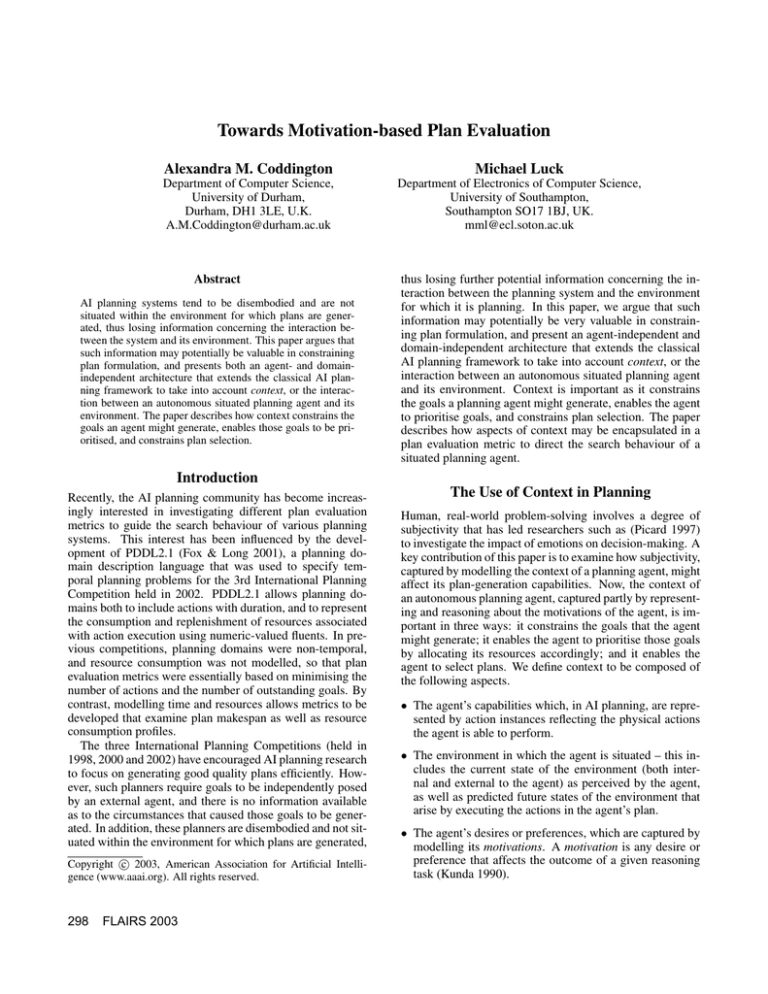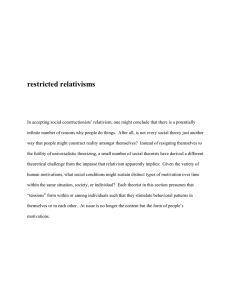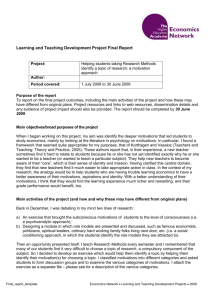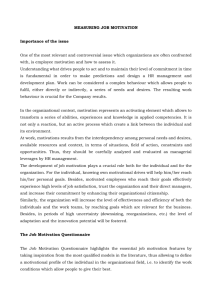
Towards Motivation-based Plan Evaluation
Alexandra M. Coddington
Michael Luck
Department of Computer Science,
University of Durham,
Durham, DH1 3LE, U.K.
A.M.Coddington@durham.ac.uk
Department of Electronics of Computer Science,
University of Southampton,
Southampton SO17 1BJ, UK.
mml@ecl.soton.ac.uk
Abstract
AI planning systems tend to be disembodied and are not
situated within the environment for which plans are generated, thus losing information concerning the interaction between the system and its environment. This paper argues that
such information may potentially be valuable in constraining
plan formulation, and presents both an agent- and domainindependent architecture that extends the classical AI planning framework to take into account context, or the interaction between an autonomous situated planning agent and its
environment. The paper describes how context constrains the
goals an agent might generate, enables those goals to be prioritised, and constrains plan selection.
thus losing further potential information concerning the interaction between the planning system and the environment
for which it is planning. In this paper, we argue that such
information may potentially be very valuable in constraining plan formulation, and present an agent-independent and
domain-independent architecture that extends the classical
AI planning framework to take into account context, or the
interaction between an autonomous situated planning agent
and its environment. Context is important as it constrains
the goals a planning agent might generate, enables the agent
to prioritise goals, and constrains plan selection. The paper
describes how aspects of context may be encapsulated in a
plan evaluation metric to direct the search behaviour of a
situated planning agent.
Introduction
Recently, the AI planning community has become increasingly interested in investigating different plan evaluation
metrics to guide the search behaviour of various planning
systems. This interest has been influenced by the development of PDDL2.1 (Fox & Long 2001), a planning domain description language that was used to specify temporal planning problems for the 3rd International Planning
Competition held in 2002. PDDL2.1 allows planning domains both to include actions with duration, and to represent
the consumption and replenishment of resources associated
with action execution using numeric-valued fluents. In previous competitions, planning domains were non-temporal,
and resource consumption was not modelled, so that plan
evaluation metrics were essentially based on minimising the
number of actions and the number of outstanding goals. By
contrast, modelling time and resources allows metrics to be
developed that examine plan makespan as well as resource
consumption profiles.
The three International Planning Competitions (held in
1998, 2000 and 2002) have encouraged AI planning research
to focus on generating good quality plans efficiently. However, such planners require goals to be independently posed
by an external agent, and there is no information available
as to the circumstances that caused those goals to be generated. In addition, these planners are disembodied and not situated within the environment for which plans are generated,
c 2003, American Association for Artificial IntelliCopyright gence (www.aaai.org). All rights reserved.
298
FLAIRS 2003
The Use of Context in Planning
Human, real-world problem-solving involves a degree of
subjectivity that has led researchers such as (Picard 1997)
to investigate the impact of emotions on decision-making. A
key contribution of this paper is to examine how subjectivity,
captured by modelling the context of a planning agent, might
affect its plan-generation capabilities. Now, the context of
an autonomous planning agent, captured partly by representing and reasoning about the motivations of the agent, is important in three ways: it constrains the goals that the agent
might generate; it enables the agent to prioritise those goals
by allocating its resources accordingly; and it enables the
agent to select plans. We define context to be composed of
the following aspects.
• The agent’s capabilities which, in AI planning, are represented by action instances reflecting the physical actions
the agent is able to perform.
• The environment in which the agent is situated – this includes the current state of the environment (both internal and external to the agent) as perceived by the agent,
as well as predicted future states of the environment that
arise by executing the actions in the agent’s plan.
• The agent’s desires or preferences, which are captured by
modelling its motivations. A motivation is any desire or
preference that affects the outcome of a given reasoning
task (Kunda 1990).
Motivations
When planning to achieve the same goal, two agents may
create different plans even though their external environment is the same. The different plans arise as a result of
differences in the internal states of those agents and are
due to the motivations of each agent. Work on motivation in computing has been limited, but dates back to Simon (1979), who explored the relation of motivation to
information-processing behaviour from a cognitive perspective. Sloman (1987) elaborated on Simon’s work, showing
how motivations are relevant to emotions and the development of a computational theory of mind. While there has
been a steady stream of research over the last twenty years,
it is only relatively recently that the incorporation of motivations into effective agent architectures, for functional purposes, has become more prevalent eg. (de Lioncourt & Luck
2002).
In the prevailing symbolic AI view, an agent may be modelled as having a set of motivations which, in human terms,
represent its basic needs and desires. Different kinds of
agent have different motivations. In animals, these motivations might represent drives such as hunger or curiosity,
whilst an autonomous truck-driving agent might have motivations concerned with fuel replenishment, conserve fuel, or
with preserving the state of the truck’s tyres, conserve tyres.
Associated with each motivation is a measure of strength,
or motivational value, which varies with changing circumstances, and which represents the driving force that directs
action to satisfy the motivation. For example, the motivational value associated with conserve fuel might be low just
after the truck-driving agent has refuelled but will gradually
increase over time as the agent drives between cities, consuming fuel. The truck-driving agent only acts to satisfy
the motivation when the strength associated with it is sufficiently high.Feedback of information from an agent’s environment causes motivational values to vary – for example, if
an agent perceives immediate danger, the motivational value
associated with self-preservation increases to a high level
causing the agent to act.
Context, especially the notion of motivation, is increasingly being seen as a means of influencing or constraining
particular aspects of behaviour in autonomous agents. In
planning agents, motivations are regarded as important in
two particular areas of interest, goal generation and plan
evaluation. Each is considered in turn below.
Norman (1997) describes a model of goal generation in
which the threshold causing goals to be generated to satisfy
one or more motivations is dynamically adjusted in response
to feedback from the planning sytem. Thus, if the planner is
currently in the process of achieving many (or few) goals,
the motivational value threshold causing goal generation is
increased (or decreased).
Goal generation is influenced by the current and predicted
future states of the environment (encapsulated within an
agent’s plan), and the current and predicted future strength
associated with an agent’s motivations.
Now, an agent’s perception of its immediate environment
may directly affect the strength associated with its motivations in such a way as to lead to the generation of goals.
For example, the sudden appearance of an oncoming vehicle may cause a sudden increase in an autonomous truckdriving agent’s motivation concerned with self-preservation
which, in turn, may lead to the generation of a goal to avoid
a collision. As well as being generated in response to the
agent’s immediate environment, goals may be generated in
response to the agent’s future predicted states of the environment (encapsulated its current plan). For example, if
an autonomous truck has generated a sequence of actions
to achieve the goal of delivering a package to a particular
destination, it can predict that it will be at that destination
at some time in the future, which may cause it to generate a
goal of refuelling at that location. The generation of goals
may also be influenced by the predicted future strength of
motivations. The truck agent may predict that, as a consequence of executing a sequence of actions involving driving
from one location to another, the motivation conserve fuel
will increase in strength. This may cause the agent to generate a goal to replenish fuel with a deadline coinciding with
the point at which the motivation is predicted to reach the
threshold leading to goal generation.
In addition, the relative importance of the various goals
generated are directly related to the strength of an agent’s
motivations. If a motivation is strong (and high in relation to
the goal generation threshold), any goal generated to satisfy
that motivation will also be important. Changes in motivational values may also cause the priority associated with
goals to change. For example, a truck-driving agent may
have the goal of delivering a parcel to a client; the priority
associated with the goal may change if the agent learns that
the client has not paid for previous deliveries.
Goal Generation
Plan Evaluation
An important feature of an autonomous planning agent is an
ability to generate goals in order that it may further its aims,
either by taking advantage of opportunities that may arise,
or by preventing undesirable situations from occurring.
Motivations directly affect the generation of goals – by
achieving a goal, an agent is able to mitigate the motivations
that led to the generation of that goal (d’Inverno & Luck
2001). For example, if the strength associated with hunger
lies above some threshold, the goal of obtaining food might
be generated. A plan to achieve the goal is generated and,
once the agent has executed the plan and the goal is satisfied,
the motivational value associated with hunger is reduced.
Motivations also enable an agent to evaluate the plans generated to achieve its goals. If a human agent executes a plan
that involves walking down a dark alley in order to achieve
the goal of having some food, when imagining executing the
plan, they might experience a small rise in their level of fear.
Through being able to predict that walking down a dark alley
will cause their fear to increase, they may choose an alternative plan (one that involves driving to their destination).
The framework presented in this paper aims to replicate this
behaviour – if one sequence of actions (or plan) chosen to
achieve some goal conflicts with the motivations of an agent,
the agent might choose an alternative sequence of actions.
FLAIRS 2003
299
vide details of generating or updating goals – others have
addressed that issue, and detailed accounts of goal generation in response to motivations and feedback from the
current plan can be found in (Luck & d’Inverno 1998;
Norman 1997).
motivations
plan
Generate/
update
goals
plan
Select best
plan
plan
Updating Motivations
plan
........
Select goal
or action
plan
Update
motivations
plan
goal
sction
good
plan
plan
Plan to
achieve goal
plan
Execute
action
bad
Recover
plan
Figure 1: The Continuous Planning/Execution Framework
A Continuous Planning Framework
The Basic Architecture
A continuous planning framework, illustrated in Figure 1,
has been designed to be both domain and agent independent
and allows the agent to reflectively evaluate, taking into account its context, when choosing its course of action.
Solid rectangular boxes represent the various processes in
the framework that are the focus of this research. Oval boxes
represent plans (including the initial and goal states), and the
agent’s motivations, which are represented as a set of tuples:
(name, value) where name is the name of the motivation,
and value is the motivational value or strength.
The framework can be viewed as a dynamic system in
which the agent continually generates goals in response to
its perceived current and predicted future states of the environment as well as in response to its motivations. Each
newly generated goal has a deadline by which it must be
achieved as well as a value indicating its importance or priority. The Select goal or action process determines whether
one of the goals should be achieved or whether one of the actions (within a plan) should be executed. If a goal is chosen,
it is passed to a planner which plans to achieve that goal. An
important part of the planning process involves determining
whether or not goals may be achieved by their deadlines as
well as assigning deadlines to actions and subgoals. The
planner generates a search space of alternatives when planning, which requires a plan evaluation metric to select the
most promising plan for further refinement (represented as
Select best plan).
When a decision is made to execute an action, the Execute action component updates the plan and the model of
the current state to reflect the changes that have occurred
following execution. If the actual outcome differs significantly from the predicted outcome (i.e. enough to undermine the plan in some way), the Recover component is
responsible for repairing the plan. In addition, as a consequence of changes to the environment and plan following execution, the agent’s motivations may change (these
are updated by the component Update motivations), which
in turn may cause new goals to be generated or existing
goals to be updated. The aim of this paper is not to pro-
300
FLAIRS 2003
The continuous planning framework of Figure 1 assumes
that motivations change only in response to physical changes
that arise within an agent’s environment. Such changes,
which are reflected by updating the agent’s initial state
model, may be caused by both the activities of the agent
as well as by the activities of other agents and physical processes occurring within the environment. For example, once
our example autonomous truck-driving agent has refuelled,
the strength of the conserve fuel motivation drops and, while
the agent drives from one city to another, the strength of the
conserve fuel motivation increases.
It could be argued, however, that motivations might also
change in response to changes in an agent’s internal state
(i.e. in a planning agent, internal state is encapsulated within
the current plan representation which contains the current
and predicted future states). For example, during the process of planning, an agent selects a new or existing action
to achieve a goal. The addition of this new action to the
plan can be viewed as constituting a new belief. As a consequence of believing that at some point in the future the
agent will be executing the new action (which, when executed, will cause the agent’s motivations to change), the
current strength associated with motivations might change.
For example, the autonomous truck-driving agent may have
a motivation associated with keeping busy. Adding a new
action to its current plan in order to achieve a goal causes
the agent to believe that at some point in the future it will
be busier, therefore leading to an immediate decrease in the
strength associated with keeping busy. This approach is
more complex to model as the strengths of motivations differ with respect to each plan, so that each plan representation must include a corresponding set of motivations, as discussed further in (Coddington 2001). Plan evaluation would
then be more difficult as, instead of evaluating the degree to
which each plan supports the same set of motivations, each
plan supports its own, different set of motivations. In order
to simplify the modelling of motivations and their relationship to goal and plan generation, we therefore assume that
motivations only change in response to physical changes to
the environment (either by the agent, or by other agents and
physical processes). When the planning agent plans, its motivations remain unaffected.
Using Motivations to Evaluate Plans
In planning to achieve a goal, a planning agent generates a
search space of alternative plans and, at each stage of the
planning process, must apply a heuristic to select the most
promising plan for further refinement. In this section, an approach based upon examining the degree to which each plan
supports or undermines the agent’s motivations is discussed.
We start by elaborating the truck-driving agent example
we have been using throughout this paper, based on the
City 1
City 2
7
4
4
2
City 5
3
City 4
3
City 3
(:action drive-truck
:parameters (truck city1 city2)
:condition (and (connects city1 city2)
(at truck city1)
(has-fuel truck))
:effect (and (not (at truck city1))
(at truck city2))
:duration 3
:pros ((pleasure 0.1))
:cons ((conserve-fuel 1.2)
(conserve-tyres 1.0)))
Figure 3: A drive-truck action.
Figure 2: The Driver Log Domain
DriverLog domain (used in the 3rd International Planning
Competition) in order to illustrate how an agent’s motivations affect the way it both generates goals and plans.
Figure 2 shows the topology of the domain, which consists of five cities connected by roads. The numbers indicate the distance from one city to another. It is the task of
a truck-driving agent to transport packages or parcels from
one city to another by some deadline. At any point in time,
the truck-driving agent may receive an instruction to collect
a package from one city, and to transport it to another city
by a fixed deadline. In order to achieve its goals in an intelligent timely manner, the truck-driving agent requires the
continuous planning framework illustrated in Figure 1.
Each time an agent executes an action within its environment, its motivations are updated to reflect the fact that it has
brought about changes to its environment. For example, as a
consequence of having driven between City 1 and City 2, the
motivation associated with conserving fuel will increase in
strength reflecting the decrease in fuel. This means that there
is a difference between the current strength associated with
the agent’s motivations and the future strength of those motivations once the agent has executed some sequence of actions. The degree to which the actions within a plan support
the agent’s motivations can be determined by predicting the
future motivations of the agent that arise as a consequence
of executing those actions. This enables the planning agent
to choose a plan containing the sequence of actions that best
support the motivations, i.e. a plan containing the sequence
of actions favoured by the agent.
In order to represent the degree to which each action may
support or undermine motivations, the action representation has been extended to include two fields, pros and cons,
where each contains a set of tuples (name, strength) representing the name of each motivation supported/undermined
by the action, together with the degree (strength) to which
executing the action will support or undermine the motivation. Currently, these values are stored in a look-up table, requiring knowledge about the domain in which the
planning agent is acting. For example, the action drivetruck(truck city1 city2) in Figure 3 has the associated set pros
consisting of the tuples ((pleasure, 0.1)) and the associated
set cons consisting of tuples (conserve-fuel, 1.2), (conservetyres 1.0)), so that when driving from City 1 to City 2,
the truck-driving agent supports pleasure to a small extent
(value 0.1), and undermines conserve-fuel and conservetyres to a greater extent (the road may be busy with traffic
and full of pot-holes).
One difficulty with associating pros and cons with each
action instance is that specific domain knowledge is required
to provide the correct instantiation. For example, an action
representing the activity of eating a meal in a restaurant,
dine (?restaurant) may support the same motivations to a
greater or lesser degree depending upon which restaurant is
selected during planning to instantiate the variable ?restaurant. For example, if the chosen restaurant is expensive,
dining there will undermine the motivation save-money to a
greater degree than dining at a cheaper restaurant. Likewise,
the pleasure motivation may receive greater support at a 3star Michelin restaurant than a restaurant without a Michelin
rating. In order to overcome this, it is assumed that the agent
knows the degree to which executing each action instance
supports or undermines its motivations. This assumes that
the agent has some way of both acquiring and learning this
information, which is beyond the scope of this paper. The
implementation of the continuous planning framework has a
look-up table containing instantiations of the fields pros and
cons for each action instance.
Though many plan evaluation functions to determine the
degree to which actions in a plan support an agent’s motivations are possible, one simple example, used in the prototype
implementation is given below.
p
p
n
valuemi −
FM =
i=1
strengthprosa
j=1
j
+
strengthconsa
j
j=1
Here, F M is the sum of the values indicating the predicted future strength associated with each of the agent’s
motivations mi ; n is the total number of motivations;
valuemi is a measure of the current strength associated with
each motivation mi ; p is the number of actions in the plan;
strengthprosaj is the degree to which each action aj in the
plan the supports motivation mi (mi belongs to a tuple in
the set pros associated with aj ); strengthconsaj is the degree to which each action aj undermines mi . As indicated
above, this is just one particular way of evaluating the degree to which a sequence of actions (or plan) supports an
agent’s motivations. There are many other ways of evaluating this support and future work will involve investigating
which method is the more effective. Plans with a low value
of F M are preferred as they support the agent’s motivations
to a greater degree than those with high F M .
In the truck-driving domain, the agent that is initially located in City 1 is given the task of delivering a package to
a destination in City 5. The three alternative routes generated in three different plans involve: driving from City 1 via
City 2 to City 5; driving from City 1 via City 2 and City 4
FLAIRS 2003
301
action
drive(c1 c2)
pros
(pleasure 0.1)
drive(c1 c3)
(pleasure 1.9)
drive(c2 c5)
(pleasure 0.2)
drive(c2 c4)
(pleasure 1.2)
drive(c4 c5)
(pleasure 1.8)
drive-(c3 c4)
(pleasure 1.2)
cons
(cons-fuel 1.2)
(cons-tyres 1.0)
(cons-fuel 0.3)
(cons-tyres 0.1)
(cons-fuel 1.0)
(cons-tyres 0.9)
(cons-fuel 0.3)
(cons-tyres 0.2)
(cons-fuel 0.3)
(cons-tyres 0.4)
(cons-fuel 0.3)
(cons-tyres 0.4)
Table 1: pros and cons associated with action instances (c1,
c2, etc. are abbreviations for City 1, City 2, etc.)
to City 5; and driving from City 1 via City 3 and City 4 to
City 5. Table 1 indicates the degree to which each action
instance supports or undermines the pleasure, conserve-fuel
and conserve-tyres motivations. Now, a standard plan evaluation function might simply take into account the number
of steps in a plan – in this case, the first route (via City 2
to City 5) is preferred as it has the least number of steps.
By contrast, a plan evaluation function that minimises the
distance travelled in each plan will choose the second plan
as the total distance travelled is 9 units. Finally, however, if
we assume that the initial motivational value associated with
pleasure, conserve-fuel and conserve-tyres is 0.0 then, using
the function described above, the preferred plan is the third
plan with F M of -3.1 (F M for the first plan is 3.8 and for
the second is 0.3).
Discussion and Conclusions
It is interesting to note the different results obtained depending on the plan evaluation mechanism. It should be clear
that the plan evaluation function F M is not effective if it is
used in isolation to guide the search for solutions to planning
problems, as it is a poor measure of progress in achieving
the goals in a plan. In experimental trials, F M was found
to be useful in combination with an evaluation heuristic that
minimised the number of actions and outstanding goals.
One limitation of the evaluation function F M described
in the previous section is that it treats each motivation as
being equal in importance to the planning agent. In practice, the planning agent may prefer to support one motivation more than another. For example, if the truck-driving
agent has an urgent delivery deadline to meet, it would not
be interested in trying to support the pleasure motivation by
choosing a route it enjoys. Likewise, it may not be so concerned with conserving fuel. The relative importance of each
motivation varies with different circumstances, but this issue
is not currently implemented and requires further examination. In addition, plan evaluation should take into account
the number of high priority goals achieved – a plan that
achieves a small number of high priority goals may be preferred over one that achieves a larger number of low priority
goals. Again, this has not been implemented and requires
302
FLAIRS 2003
further examination.
In this paper, we have described how modelling the motivations of an agent can affect AI planning in terms of generating goals, assigning values indicating the priority of each
goal, and choosing the best plan (i.e. the plan that best supports the agent’s motivations). While others have recognised
the importance of motivation (e.g. Luck (1993) describes
how motivations can be used to bias machine discovery to
suit the current circumstances, and Norman (1997) describes
how the number of goals being achieved at any given time
can dynamically alter the motivational value threshold affecting goal generation), there has been almost no work on
the role of motivation in plan evaluation. Our work addresses that omission, both through the development of an
conceptual model for motivated planning, and an implemented system. While the general framework has been set
with positive initial results, including experimental trials,
more remains to be done, especially in drilling down further
into aspects discussed. (One immediate avenue to explore
relates to the closer integration of separate models of goal
generation and plan evaluation independently developed by
the authors, but based on the same underlying motivational
principles.) It is clear, nevertheless, that motivations can
potentially provide an appropriate means for concentrating
attention on the salient aspects of a problem to offer more
effective planning behaviour.
References
Coddington, A. M. 2001. Self-motivated Planning in Autonomous Agents. Ph.D. Dissertation, University of London.
de Lioncourt, S. W., and Luck, M. 2002. Motivated Agent
Behaviour and Requirements Applied to Virtual Emergencies. Springer. 43–60. LNAI 2322.
d’Inverno, M., and Luck, M. 2001. Understanding Agent
Systems. Springer.
Fox, M., and Long, D. 2001. PDDL2.1 : An extension to
PDDL for expressing temporal planning domains. Technical report, Department of Computer Science, University of
Durham, UK.
Kunda, Z. 1990. The case for motivated reasoning. Psychological Bulletin 108(3):480–498.
Luck, M., and d’Inverno, M. 1998. Motivated behaviour
for goal adoption. In Zhang, and Lukose., eds., Multi-Agent
Systems: Theories, Languages and Applications: Proceedings of the 4th Australian Workshop on Distributed AI, 58–
73. Springer. LNAI 1544.
Luck, M. M. 1993. Motivated Inductive Discovery. Ph.D.
Dissertation, University of London.
Norman, T. J. F. 1997. Motivation-based Direction of Planning Attention in Agents with Goal Autonomy. Ph.D. Dissertation, University of London.
Picard, R. 1997. Affective Computing. MIT Press.
Simon, H. A. 1979. Motivational and emotional controls
of cognition. In Models of Thought. Yale University Press.
Sloman, A. 1987. Motives, mechanisms, and emotions.
Cognition and Emotion 1(3).







